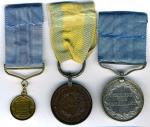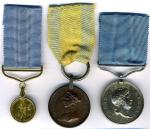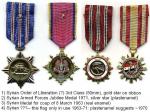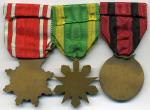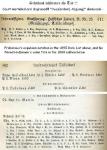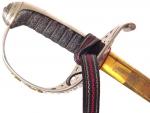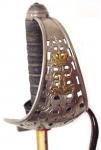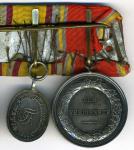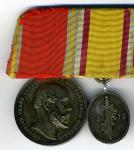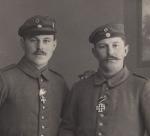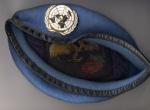-
Posts
29,251 -
Joined
-
Last visited
-
Days Won
84
Content Type
Profiles
Forums
Blogs
Gallery
Events
Store
Everything posted by Chris Boonzaier
-
From Rick... Note: the “Waterloo Ducat” is FOR DISPLAY only with the NAMED PAIR of 1 of the 8 recipients. No harm has been done to the Dutch gold piece as a coin—it rests in a removable frame, as a “transformer” capable of being worn as a jewelry pendant or on the nicely crafted matching gold “medal suspension.” The story behind that peculiar “decoration” is that Duke Friedrich Wilhelm of Brunswick (killed in action at Quatrebras 16 June 1815) had given some 1814 Dutch gold coins to his sons the Princes Carl and Wilhelm. They decided to hand these out to enlisted men who had distinguished themselves at the Waterloo battles, and 8 Brunswickers were so decorated at Clichy near Paris on 13 August 1815. The 8 Brunswick soldiers were: Sergeant Eggeling of the Hussar Regiment Uhlan Lindemann of the Uhlan Squadron Bombardier Buchner/Büchner of the Foot Battery Soldat Heilemann of the Leib-Bataillon Sergeant Fischer of the 1st Light/Jäger Battalion Sergeant Kinkel of the 1st Line Battalion Sergeant Fuhr of the 2nd Line Battalion, and Sergeant Müller of the 3rd Line Battalion The Brunswick Waterloo Medal and Hannover Guelphic/? Civil Merit Medal here are named to the first named above—Sergeant Wilhelm Eggeling of the Hussar Regiment. Eggeling does NOT appear on the Guelphic Medals Roll—which MAY be simply because only Hanoverians were listed. Or it is an anomalous Civil Merit Medal (Roll as yet untranscribed) bearing his rank and unit. The only way to tell the two Hanoverian Medals apart were by the rim inscriptions. There are discrepancies of 8 to 10 on the numbers of Guelph Medals awarded, with sources agreeing that 503 went to members of the King’s German legion and 82 to members of the Hanoverian army. That leaves 8 or 10… POSSIBLY to “uncounted” non-Hanoverians like Eggeling. Duke Wilhelm of Brunswick on 16 June 1834 authorized the 6 surviving “Waterloo Ehren-Dukaten” recipients (Buchner/Büchner and Kinkel had died in the interim) to receive the Merit Cross 2nd Class of the Brunswick House Order of Henry the Lion in place of the dangling Dutch coins. Since the insignia of the Henry the Lion Order had to be returned on a recipient’s death, Sergeant Eggeling’s post-1834 trio no longer exists… just his issued pair of named medals—one as potentially rare as the long lost Ducat represented here by this lovely display recreation of his golden reward using an original gold coin. 5,607 Brunswick Waterloo Medals, made out of bronze from captured French cannons, were awarded (like the British Waterloo Medals, to living recipients or next of kin of deceased soldiers) in 1818. Shared by the Traveling Museum, to whose members many thanks are owed for allowing their treasures to be Epsonized. My thanks also to Chris for posting since I am not online. Rick Research Sources: Andreas Thies and Wilhelm Hapke, “Orden und Ehrenzeichen des Königreiches Hannover,” 1981. Aug. Finkam, “Die an Braunschweiger und Hannoveraner verliehenen Ehrenzeichen,” 1901 Roger Reckewell and Jens Fischer, “Orden, Ehren- und Abzeichen des Herzogtums Braunschweig-Lüneburg von 1809 bis 1918,” 1987.
-
From Rick.... These lovely though “mysterious” awards—at least as far as finding information is concerned—fell into my offline paws earlier this year. ALL that I know about them is included in the scan captions! Any additional information would be greatly appreciated, since I find Z-E-R-O “out there” in published literature. The reverses are all plain. Excellent quality, bronze—presumably Swiss or French-made. These are from the next decade… reveal a transition from real enamel to plastenamel… and present one award I cannot distinguish the class of and another that I cannot even identify.
-
These lovely though “mysterious” awards—at least as far as finding information is concerned—fell into my offline paws earlier this year. ALL that I know about them is included in the scan captions! Any additional information would be greatly appreciated, since I find Z-E-R-O “out there” in published literature. The reverses are all plain. Excellent quality, bronze—presumably Swiss or French-made. These are from the next decade… reveal a transition from real enamel to plastenamel… and present one award I cannot distinguish the class of and another that I cannot even identify.
-
Still resident in Landwehrbezirk I, Darmstadt, he returned to the colors—and in his old regiment! On 14 April 1916 the former Lt dR aD of FAR 25 was even promoted to Oberleutnant dR aD in the IInd Replacement Battalion of his old unit. Crucified metaphorically, after 20 years of social purgatory Herr Frobénius had come back from the legally “dead” again! Sources: Annual Prussian Army Rank Lists 1891 to 1898, Militär-Wochenblätter for the war years, 1955 DSJB article on Rank List abbreviations… and the invaluable experience and encyclopæedic knowledge of GMIC’s arb and GlennJ. My thanks to the owner for sharing and to … for posting since I am not online. Rick Research
-
What that mild but significantly punctuated abbreviation MEANT was… that the ex-officer so named had been convicted by military court martial and expelled from the army. Not simply removed from the officer corps, but excluded from the officer caste (Offizierstand). In the frightening but now almost forgotten Old English legal sense, the ex-officer was a “nothing”—literally a non-person. If senior enough, his pension was forfeited, as were his decorations. Barred from ever wearing uniform again, he was also banned from use of his former military title. Without status, without income—the convict faced social suicide as well as the obvious hint that one bullet in the revolver would be “doing the right thing.” But such disgrace was not, technically, a death sentence. Examining more and more cases, about 1 in 4 cashiered officers were able to redeem themselves to some degree once the Great War‘s horrific casualties meant SOME offenses might be pardoned. Such salvation was never certain, yet Herr Frobénius survived.
-
Herrn Holzmann and Frobénius were comrades in Hessian Corps-Artillery Regiment 25. Presenter Holzmann was commissioned Seconde-Lieutenant der Reserve on 14 October 1890. Recipient of this noble gift Frobénius was commissioned Seconde-Lieutenant der Reserve on 18 January 1891. Both appear together by this invisible seniority (dates not ever published in Prussian army Rank Lists for reservists) in the annual Rank Lists from 1891 to 1894. In 1895, separated with deceptive subtlety by a dash and seemingly innocuous abbreviation, Frobénius left military duty. “— Auss. Abg.” meant “Ausserdem Abgang.” Following notations for transfers, retirements with pensions and right to wear uniform, retirements (voluntary and involuntary—but those are another story) and departure from a unit by reason of death, last (faithful readers will note that this category FOLLOWS death….) came “departure by other than the previous.” Friend Holzmann now wandered from Reserve status into the Landwehr, moving residences three times in three years. In 1898 fate caught up with him too and he also “departed by other than the previous.”
-
From Rick There is an exquisite—if lethal—beauty to Damascus steel swords. Faithful GMIC readers will have noted many previous tragic real-life epics in these pages. Those who live by the sword, and all of that. Yet often as the glib motto “death before dishonour” comes up… our tale today is about dishonour before death. As Edward Gibbon noted over two centuries ago, “(h)istory…is, indeed, little more than the register of the crimes, follies, and misfortunes of mankind.” This scarce Hessian pattern basket-hilt sword bears the simple inscription “Holzmann s/l/ Frobenius 1891.” Can’t ask, can’t tell… now….
-
Here are some nifty close-ups of these awards: I went through the 1906 –Schwerin Staatskalendar, figuring that was a good year to pick because civil servants would have “glass ceiling-ed” at levels likely to have received their maximum awards. There were 143 Silver Merit Medal holders and 31 Kriegerverein Medal holders. Only TWO held both, and neither could be THIS man, since both had other awards. But that sort of odds may mean this medal bar does turn out traceable, some day. The 1913 Staatskalendar added 1 holder of both but none of those 3 could have been the wearer of this medal bar. In 1913 there were 117 Silver Merit Medal holders and 36 (both figures including the pairs, 2 of whom were the same in 1906) but I was simply counting singles versus pairs, so don’t know how many were new holders and how many had retired in the interim. At least half, if not more, of the Kriegerverein Medal holders had NO other award. Most 1870 veterans would have been retiring about then. Thanks to the owner for sharing and to … for posting since I am not online. Rick Research
-
Greetings from Rick Thanks to a member of the Traveling Museum, this interesting bar came by to be Epsonized for sharing with you all. Hopefully of particular interest to seeheld: In first place, the HUGE, heavy Merit Medal in silver awarded from 1872 to 1918. Oddly, the obverse bust was not changed with the final Grand Duke’s image and titles. This Medal is 41mm in diameter and a hefty 30 grams of silver… quite a contrast with the medal in second place. The Kriegerverein Medal was bestowed from 1899 to 1918. It was designed to reflect the 1813/15 Military Merit Medal. Only 29mm x 24mm and a mere 10 grams of silver, it is dwarfed by the Merit Medal. The owner and I are hoping that it MIGHT be possible to identify the original recipient once seeheld’s massive labours on the-Schwerin Rolls are completed. This could, we hope, be one of those cases where what is NOT on this bar narrows down the suspects list. As a PAIR, these two were not at all common.
-
Lovely gold Baden Zähringen Lion Order-Knight 1st Class (BZ3a), 1870/71 War Medal, Baden Campaign Medal with (UNDER-mounted !!!) bars for 1866 and 1870-71, and Baden 25 Years Service Cross. The bar dates from before 1895, when battle bars were authorized for the 1870/71 Medal. Either this fellow was an incredibly ancient retired army officer not decorated for either 1866 or 1870/71, or more likely was a young officer in both wars who went into the Gendarmerie. The Baden 25 was not given to officers in Baden military units after the treaty absorbing Baden’s forces into those of the Empire. I don’t have a Baden Court and State Handbook before 1902, so can’t say whether this quartet MIGHT be traceable to a Gendarmerie officer of circa 1890. Thanks to the owner for bringing it by to visit and to … posting since I’m not online. Rick Research
-

EK 1914 Who got what and when....
Chris Boonzaier replied to Chris Boonzaier's topic in Germany: All Eras: The Iron Cross
Two bavarians...... why does the one have the bMvK and the other the EK ? When a Bavarian Div commander was awarding medals, was the Bavarian or the Prussian higher? When the Hessen Div Commander was dishing out, was the Hessen Bravery or the EK2 higher? Was a coin flipped to see who got which one? Any idea what system was used to decide? Best Chris -

EK 1914 Who got what and when....
Chris Boonzaier posted a topic in Germany: All Eras: The Iron Cross
-

Heer Max Reck
Chris Boonzaier replied to Paul R's topic in Germany: Third Reich: Research, Documentation & Photographs
This is an interesting project indeed! Good luck on it, it wont be easy.... you somehow never find the boards you need :-( -

UNITED NATIONS MILITARIA.
Chris Boonzaier replied to Irish's topic in Modern Campaigns and Conflicts
Mine from Bosnia.... we only ever wore them twice, on the way into sarajevo, then out again... for the 7 months there it was always helmets. -

FYI: Stolen Sword Collection
Chris Boonzaier replied to Jonathan Hopkins's topic in Swords & Edged Weapons
That must have been a huge blow to the owner :-( -
Thanks Glenn!! The mention of the 180 helps a lot. He seems to have been there as Oberleutnant d. Res. from the Outbreak of the war then, as Führer d. Gr. Baggage, part of the Regt. Staff. I dont know if he still had that function in 1916, although he was still with the regt then obviously. Best Chris



